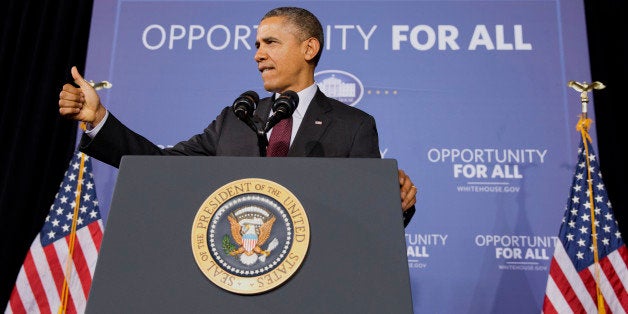
Most Americans may not realize it, but a great many of President Obama's recently announced Immigration Accountability Executive Actions have little to do with bringing anyone out of the shadows. They are targeted at making the legal immigration system work as well as it can until Congress fixes it. This is important because, as credible economics studies show, a functional business immigration system will boost the economy by generating tax revenue, adding billions to the GDP and creating jobs for American workers.
Here are four of the key business fixes the president is planning to make through his executive actions.
1. Modernize the Employment-Based Immigrant System.
The employment based green card system has not been updated by Congress in nearly a quarter century. Today the obsolete system, with its inadequate green card numbers for key employees and years-long green card queues, stymies economic growth and global competitiveness.
Mr. Obama has directed U.S. Citizenship and Immigration Services to work closely with the Department of State to make sure all visas authorized by Congress are actually issued -- all too often visas in shortage occupations have been wasted by bureaucratic inefficiency. Second, the president has directed the Department of State to modernize the way it monitors the visa quota system. Finally, the executive actions direct USCIS to ensure that employment-based immigrants whose visas have been stuck in long backlogs have greater flexibility in changing jobs or employers.
Not everyone is happy with the Administration's proposal. Some in the high-tech industry are disappointed that the executive actions will not make unused green cards available to employment based immigrants -- a process known as "recapture."
2. Promote Research and Development in the U.S.
The Administration will review the existing immigration law with an eye on enhancing opportunities for foreign inventors, researchers and founders of start-ups wishing to conduct research and development, and creating jobs for American workers
The executive actions outline two key ways to do this:
First, the immigration law permits certain foreign nationals with advance degrees or exceptional ability to immigrate without employer sponsorship if their work is in the "national interest." Such immigrants might include, for example, a highly accomplished medical researcher who has developed ground breaking medical innovations targeted at congenital heart failure or an engineer whose inventions have led to more efficient energy consumption.
But the rules governing "national interest waiver" are vague and the visa is underutilized, undoubtedly costing the U.S. precious foreign talent. The Administration will clarify the rules governing the national interest category with an eye on economic growth.
Second, the outmoded immigration system has very few visa options for entrepreneurs, effectively limiting critical investment and job creating opportunities. In 2012, for example, Ashaf Darash, a U.S. educated Israeli entrepreneur, was looking to hire more workers for Regpak, the highly successful San Francisco-based company he founded after graduation. But because of limited visa options Darash found himself fighting to stay in the U.S. rather than focusing on his growing company. Job creators like Ashaf Darash should be welcomed with open arms, not shut out by an inflexible set of visa rules better suited to America in the 20th century than a nation looking to maintain its competitive edge in 21st century.
The executive actions direct the immigration agency to use the "public interest parole" provisions of the law to attract and retain inventors, researchers, and founders of start-up companies "who have been awarded substantial U.S. investor financing or otherwise hold the promise of innovation and job creation through the development of new technologies or the pursuit of cutting edge research." It is hoped that the parole authority can be used to permit promising individuals to "temporarily pursue research and development of promising new ideas and businesses in the United States, rather than abroad."
3. Reform "Optional Practical Training" for Foreign Graduates Of U.S. Universities.
Foreign students who earn their degrees from U.S. universities have long been able to engage in practical training for 12 months after they graduate. "We trained them here," so the thinking goes, "we might as well benefit from their American education."
The Administration will look for ways to expand practical training, with particular emphasis on science, technology, engineering and math graduates. There will also be closer scrutiny of the training programs and efforts to ensure consistency with labor market protections for U.S. workers.
While the details haven't been released, it is hoped that greater availability of STEM graduates will help alleviate shortages in the high-tech industry while providing more post degree "hands on" education for foreign graduates. Still there are those that say the STEM extensions are too modest, especially given the arbitrary limits Congress placed on the number of H-1B visas in 1990.
4. Make the Rigid Legal Immigration Line A Bit More Flexible For Skilled Workers And Their Spouses Waiting For Green Cards.
The dysfunctional employment-based immigration system is plagued with processing delays and backlogs that require immigrants to wait years and years for a visa -- even after the Department of Labor has certified there are no qualified U.S. workers available for the job. While they wait in the "legal immigration line" immigrants and their spouses can be deprived of job growth and other employment opportunities.
The executive actions will, hopefully, add much needed flexibility to the employment-based immigration process.
Now It's Up To Congress To Pass Immigration Reform.
President Obama cannot fix the broken immigration system on his own -- he needs Congress to pass a bill. But until Congress acts the president can (and should) use his authority to create jobs for American workers and give American businesses the tools they need to remain globally competitive.
